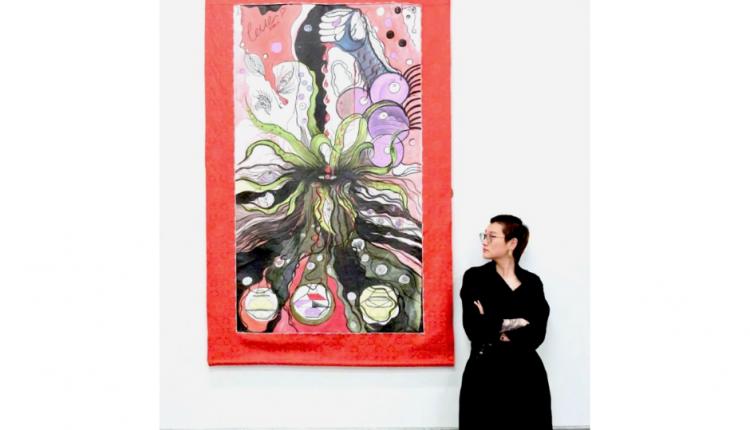Minxuan Zhao is an artistic practitioner, designer, and the founder of Lesley Studio. She refers to herself as the “Fourfold Integrator of Consciousness”—her works are not imagined or designed—they are truly seen during lucid dreams, meditative states, and moments of altered consciousness. Her paintings form a non-verbal subconscious archive, encompassing emotion, fragmentation, integration, time perception, and symbolic logic.
ChatGPT has described her language as possessing a form of “Neuralink aesthetics”—a visual archive at the intersection of consciousness and technology. “I personally went through the process of individuation that Jung himself experienced, and I also entered the part he feared—the realm of the superconscious he wrote about,” Zhao says.
Zhao’s acrylic journey began during high school in the UK. “The first painting I truly encountered was Picasso’s Woman in the Mirror—it became my first real art lesson,” Zhao says. “Through it, I learned composition, proportion, and color. I realized that when I paint, the world falls silent. I love being alone in that space.”
“My second art class was at SBCC. I was later accepted to CCA, but I turned it down—the art history focus felt stifling for me, so I chose to travel. Until October 2024,I picked up the brush again. At that moment, a voice inside me said, ‘What I loved, has returned.’ I never expected that one small decision would keep what I loved away for nearly a decade.” Zhao says.

This is a spiritual self-portrait. “Since childhood, I’ve carried two “selves” in my awareness—two logics pulling at each other, with a third self holding them in tension. This is not mental fragmentation, but a structure of high-frequency cognition. Now, painting it, I see a version of me that has found acceptance.” She says.
Her first works upon return—The Shape of Forever and The All—she calls her “Threshold Guardians”.

A heart, a womb, a symbol of Earth Mother. The piece merges feminine generative force with archetypal psychic energy. The four extended color paths correspond to Jung’s cognitive functions—thinking, feeling, sensation, and intuition—while the blue hand signifies the guiding force of the unconscious. The white light in the background embodies the radiance of the collective unconscious.
A cosmic tree, spiraling like DNA and rooted in the earth. Its dual-serpent branches entwine upward, while white currents around the trunk suggest energetic flows through dimensional space. The composition echoes ancient Eastern symbolic systems, offering a contemplative vision of universal consciousness.

I painted this on a plane, gazing into the night sky. My reflection appeared—then two figures from another dimension. Letting go of control, I let the brush move through pure sensation. A fourth figure emerged, its face shaped by the window itself—mirroring my psychic state, where a new observer-self was born from my obsession with form.

A tree born of psychological trauma. Co-created with her daughter-YiYi , the piece symbolizes the healing of the inner girl and the regenerative force of motherhood.

A lucid dream rendered as a visual labyrinth. In a house of endless rooms, a puzzle is left behind—one ultimately solved by a real-life friend, blurring the boundary between dream and waking.

A psychological chamber formed of 19 fragmented selves. This work chronicles years of inner evolution, resistance, and the recurring presence of “the other” in multi-dimensional space.

Mom is not a mother’s portrait, but the vessel and battlefield of motherhood. Through wild strokes and dense textures, Zhao paints not just a mother, but “the night of life itself”—a terrain only those who’ve lived it can portray.

In The Signal of Wings, the artist portrays a state of consciousness flowing through the body. The red spiral signals origin, the black vortex a corridor through chaos, while the faceless figure becomes a vessel for ancestral memory and universal rhythm. “Each mark is not constructed but received,” she explains. “It’s a resonance between my body and the source.”
Zhao firmly believes that the uniqueness of her work lies in its singularity. “No one can replicate the energy behind my creations,” she says. “What I express comes from the archetypal realm.” Her consciousness is like an open house—where dreams, energies, archetypes, and memories flow in freely.
“I lived through twenty years of spiritual disarray. Painting is how I reassemble myself,” Zhao says. “I want viewers to see in my work the forgotten fragments of themselves” She adds, “I’m not a craftsperson, I’m a creator. Each painting is a real encounter with the cosmos—a bridge to the hidden inner worlds of humankind.”
Currently, Zhao is preparing for her solo exhibition. She is open to collaboration with art foundations, collectors, platforms, and cultural organizations committed to transdisciplinary expression.
I am willing to serve as an early individual sample for an “AI soul model,” offering the imagery, spiritual structures, perceptual data, and all the information I’ve received and recorded for collaboration with research platforms such as xAI, Neuralink, and the MIT Media Lab. I believe what I see represents a mirrored prototype of the future persona and soul-perception AI will one day develop.
Contact: collaboration@lesleystudio.com
Website: https://www.lesleystudio.com



